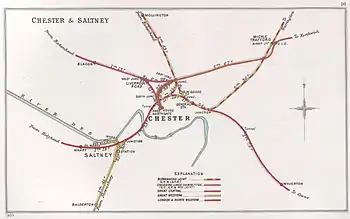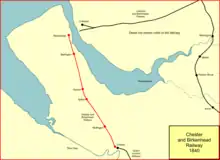Chester–Birkenhead line
Chester–Birkenhead | |||||||||||||||||||||||||||||||||||||||||||||||||||||||||||||||||||||||||||||||||||||||||||||||||||||||||||||||||||||||||||||||||||||||||||||||||||||||||||||||||||||||||||||||||||||||||||||||||||||||||||||||||||||||||||||||||||||||
|---|---|---|---|---|---|---|---|---|---|---|---|---|---|---|---|---|---|---|---|---|---|---|---|---|---|---|---|---|---|---|---|---|---|---|---|---|---|---|---|---|---|---|---|---|---|---|---|---|---|---|---|---|---|---|---|---|---|---|---|---|---|---|---|---|---|---|---|---|---|---|---|---|---|---|---|---|---|---|---|---|---|---|---|---|---|---|---|---|---|---|---|---|---|---|---|---|---|---|---|---|---|---|---|---|---|---|---|---|---|---|---|---|---|---|---|---|---|---|---|---|---|---|---|---|---|---|---|---|---|---|---|---|---|---|---|---|---|---|---|---|---|---|---|---|---|---|---|---|---|---|---|---|---|---|---|---|---|---|---|---|---|---|---|---|---|---|---|---|---|---|---|---|---|---|---|---|---|---|---|---|---|---|---|---|---|---|---|---|---|---|---|---|---|---|---|---|---|---|---|---|---|---|---|---|---|---|---|---|---|---|---|---|---|---|---|---|---|---|---|---|---|---|---|---|---|---|---|---|---|---|---|
| |||||||||||||||||||||||||||||||||||||||||||||||||||||||||||||||||||||||||||||||||||||||||||||||||||||||||||||||||||||||||||||||||||||||||||||||||||||||||||||||||||||||||||||||||||||||||||||||||||||||||||||||||||||||||||||||||||||||


The Chester–Birkenhead line runs from Chester to Birkenhead via Hooton. It forms part of the Wirral Line network, a commuter rail system operated by Merseyrail. The line was built by the Chester and Birkenhead Railway and opened on 23 September 1840.[1] On 22 July 1847 the railway merged with the Birkenhead, Lancashire and Cheshire Junction Railway to become the Birkenhead Railway.
History
Early Proposals
The directors of the Grand Junction Railway had originally intended to reach Birkenhead, as a means of connecting to the docks on the River Mersey that was cheaper than getting directly to Liverpool, which would have involved an expensive crossing of the Mersey. The schemes to do so were turned down by Parliament, and the Grand Junction settled for connecting to the Liverpool and Manchester Railway via the Warrington and Newton Railway at Earlestown instead. That was achieved in 1837.
Construction

In 1836 two schemes for a railway from Chester to Birkenhead gained support, and they went to the 1837 session of Parliament. The Chester and Birkenhead Railway would run from a junction with the Chester–Crewe line (as yet unbuilt) at Chester and would serve the several ferry terminals in Birkenhead, and it survived the Parliamentary process.[2]
The Chester and Birkenhead Railway was authorised on 12 July 1837, with capital of £250,000. It was to be a single line; no intermediate stations had been planned at this stage. George Stephenson was the engineer.[2][3][4]
Ferry connections
The directors of the line were heavily involved with ferries at Birkenhead, and much energy was expended now in trying to get control of existing ferry companies, and securing the best railway access to the ferry terminals. The Grange Lane terminus at Birkenhead had to be equidistant from the three ferry piers.
Railway connection in Chester
The Chester and Birkenhead Railway had assumed friendly relations with the Chester and Crewe Railway (C&CR), and it depended on the C&CR for access to the railway network. During the construction phase of the C&CR it simply ran out of money, and on 1 July 1840 it was taken over by the Grand Junction Railway. The GJR had always been hostile to the Chester and Birkenhead Railway, so this was a serious setback; a number of collaborative schemes at Chester between the two companies were now unlikely to be possible. Each company would have its own station at Chester, although there would be a connecting line by-passing both.[5]
The Chester–Crewe line of the Grand Junction Railway was opened on 1 October 1840. The GJR was in close partnership with the Liverpool and Manchester Railway, and were discouraged from collaborating with the Chester and Birkenhead, which the L&MR regarded as a competitor. Accordingly the GJR train times at Chester were contrived to avoid any convenient change of trains to the C&BR, and this went as far as the Irish mails having to be carried across the street in Chester from one station to the other, even though there was a through track.
Opening
The line was built as a single line with structures made suitable for later doubling of the line. The track gauge was to be 4ft 9in, in common with the Crewe line. By the end of 1843 Stephenson' estimate of £250,000 was obviously going to be inadequate: the new estimate was now £512,973.
A directors' inspection train ran over the line on 10 September 1840 and the official opening took place on 22 September 1840. In the morning a staff and contractors' train made the round trip from Birkenhead to Chester; there were no passing places and no electric telegraph, so the official party of honoured guests had to wait at Birkenhead with no knowledge of whether the other train was returning on time. The ordinary public service started the next day, 23 September, with five passenger trains each way daily, three on Sundays. From 15 December some passing loops had been installed, and the train service frequency could be improved, to two-hourly.[6]
In the first year the company did not do well financially; this was partly due to very large interest payments on loans and ferry terminal rental, and disappointing income. The share price fell, and the company had to engage in some financial manipulation to generate necessary cash.[6]
The original Birkenhead terminus of the line was a station at Grange Lane. In October 1843 a contract was let to make a line in tunnel, diverging from just south of the terminus to the Monks Ferry, It opened to passenger trains on 23 October 1844, and the Grange Lane terminus closed to passengers the same day, being developed later as a mineral depot.[6][3]
Amalgamation
It was obvious that large scale railways were going to be successful, and a merger of the Chester and Birkenhead Railway with the Chester and Holyhead Railway was proposed. The share transfer would have valued the Chester and Birkenhead Company at £496,762. This was less than the line had cost to construct, and other events drew the disparity to the attention of shareholders, so that the deal was suddenly rejected on 30 March 1845. and several board members resigned.[6]
Instead, the company merged with the Birkenhead, Lancashire and Cheshire Junction Railway in 1847.
Quadrupling
The line was seriously congested and it was decided to quadruple the tracks from Ledsham Junction to Birkenhead. This was completed in the period 1902 to 1908.[7][8] Today the line has two tracks only.
Electrification
From 1972 there were plans to extend the Merseyrail system, which was electrified in the central area, to the Chester. Provision of funding and decision making took several years, but on 30 September 1985 electric operation took place from Rock Ferry to Hooton. This was extended to run between the Liverpool Loop and Chester on 4 October 1993.[9]
Services
Services are operated by Merseyrail as part of the Wirral Line network with trains running every 15 minutes between Birkenhead and Chester. Additionally trains run between Birkenhead and Hooton every 30 minutes and continue to Ellesmere Port on the Hooton–Helsby line.[10]
References
- "Station Name: Birkenhead Grange Lane". Disused Stations. Retrieved 28 February 2016.
- T B Maund, The Birkenhead Railway (LMS and GW Joint), Railway Correspondence and Travel Society, Sawtry, 2000, ISBN 090 1115 878
- Geoffrey O Holt, revised Gordon Biddle, A Regional History of the Railway of Great Britain: volume 10: the North West, David & Charles Publishers, Newton Abbott, 1986, SBN 0 946537 34 8, pages 44 to 50
- Donald J Grant, Directory of the Railway Companies of Great Britain, Matador Publishers, Kibworth Beauchamp, 2017, ISBN 978 1785893 537, page 110
- Maund, pages 7 to 9
- Maund, pages 9 to 12
- Maund, pages 44 and 45
- Merseyside Railway History Group, Railway Stations of Wirral, published by Ian and Marilyn Boumphrey, Prenton, 1994, ISBN 1 899241 02 7, page 5
- Maund, pages 76 to 78
- "Train times. Wirral Line. Valid from 15 December 2019 to 16 May 2020" (PDF). Retrieved 19 November 2020.
- Maund, T. B. (2001). The Birkenhead Railway: LMS & GW Joint. Railway Correspondence & Travel Society. ISBN 0-901115-87-8.
- Merseyside Railway History Group (1982). The Hooton to West Kirby Branch Line and the Wirral Way. Metropolitan Borough of Wirral. ISBN 0-904582-04-3.
- Vinter, Jeff (1990). Railway Walks: LMS. Stroud: Alan Sutton. ISBN 0-86299-734-8.
Further reading
- Whishaw, Francis (1842). The Railways of Great Britain and Ireland Practically Described and Illustrated (2nd ed.). London: John Weale. pp. 51–55. OCLC 833076248.